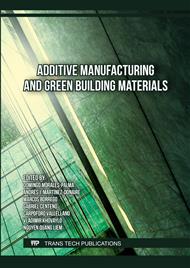[1]
"Additive Manufacturing - General Principles Terminology (ASTM52900)," 2015.
Google Scholar
[2]
A. Dass and A. Moridi, "State of the art in directed energy deposition: From additive manufacturing to materials design," Coatings, vol. 9, no. 7. MDPI AG, 2019.
DOI: 10.3390/COATINGS9070418
Google Scholar
[3]
I. John Solomon, P. Sevvel, J. Gunasekaran, and P. Tanushkumaar, "A review on additive manufacturing of alloys using laser metal deposition," Mater Today Proc, vol. 64, p.44–50, Jan. 2022.
DOI: 10.1016/j.matpr.2022.03.510
Google Scholar
[4]
F. Mazzucato, M. Menerini, and A. Valente, "Laser-based Hybrid System for Inconel 718 part repairing," in Procedia CIRP, 2020, vol. 95, p.29–34.
DOI: 10.1016/j.procir.2020.01.164
Google Scholar
[5]
M. Cortina, J. I. Arrizubieta, J. E. Ruiz, E. Ukar, and A. Lamikiz, "Latest developments in industrial hybrid machine tools that combine additive and subtractive operations," Materials, vol. 11, no. 12. MDPI AG, Dec. 18, 2018.
DOI: 10.3390/ma11122583
Google Scholar
[6]
J. P. M. Pragana, R. F. V. Sampaio, I. M. F. Bragança, C. M. A. Silva, and P. A. F. Martins, "Hybrid metal additive manufacturing: A state–of–the-art review," Advances in Industrial and Manufacturing Engineering, vol. 2. Elsevier B.V., May 01, 2021.
DOI: 10.1016/j.aime.2021.100032
Google Scholar
[7]
J. Ma, Y. Zhang, J. Li, D. Cui, Z. Wang, and J. Wang, "Microstructure and mechanical properties of forging-additive hybrid manufactured Ti–6Al–4V alloys," Materials Science and Engineering A, vol. 811, Apr. 2021.
DOI: 10.1016/j.msea.2021.140984
Google Scholar
[8]
F. Meiners et al., "New hybrid manufacturing routes combining forging and additive manufacturing to efficiently produce high performance components from Ti-6Al-4V," in Procedia Manufacturing, 2020, vol. 47, p.261–267.
DOI: 10.1016/j.promfg.2020.04.215
Google Scholar
[9]
Y. Zhu, J. Li, X. Tian, H. Wang, and D. Liu, "Microstructure and mechanical properties of hybrid fabricated Ti-6.5Al-3.5Mo-1.5Zr-0.3Si titanium alloy by laser additive manufacturing," Materials Science and Engineering A, vol. 607, p.427–434, 2014.
DOI: 10.1016/j.msea.2014.04.019
Google Scholar
[10]
M. Godec et al., "Hybrid additive manufacturing of Inconel 718 for future space applications," Mater Charact, vol. 172, Feb. 2021.
DOI: 10.1016/j.matchar.2020.110842
Google Scholar
[11]
T. Saracyakupoglu, "The Qualification of the Additively Manufactured Parts in the Aviation Industry," American Journal of Aerospace Engineering, vol. 6, no. 1, p.1, 2019.
DOI: 10.11648/j.ajae.20190601.11
Google Scholar
[12]
E. Hosseini and V. A. Popovich, "A review of mechanical properties of additively manufactured Inconel 718," Additive Manufacturing, vol. 30. Elsevier B.V., Dec. 01, 2019.
DOI: 10.1016/j.addma.2019.100877
Google Scholar
[13]
"Finite element modeling and simulation with ANSYS Workbench (CRC Press)".
Google Scholar
[14]
E. Saberi, S. Nakhodchi, A. Dargahi, and K. Nikbin, "Predicting stress and creep life in Inconel 718 blade-disk attachments," Eng Fail Anal, vol. 108, Jan. 2020.
DOI: 10.1016/j.engfailanal.2019.104226
Google Scholar
[15]
A. Kumar Maurya and A. Kumar, "Microstructure and Mechanical Properties of Additive Manufactured IN718 Alloy after Heat-Treatment."
Google Scholar
[16]
C. Zhong, A. Gasser, J. Kittel, K. Wissenbach, and R. Poprawe, "Improvement of material performance of Inconel 718 formed by high deposition-rate laser metal deposition," Mater Des, vol. 98, p.128–134, May 2016.
DOI: 10.1016/j.matdes.2016.03.006
Google Scholar
[17]
"Rolls Royce." https://www.rolls-royce.com/products-and-services/civil-aerospace/ widebody/trent-10 00.aspx#section-technology (accessed Feb. 02, 2023).
DOI: 10.1093/ww/9780199540884.013.u2000044
Google Scholar
[18]
"Aciturri." https://www.aciturri.com/es/aeroengines/programas/cmap/mount-lugs (accessed Feb. 02, 2023).
Google Scholar
[19]
Nickel Alloy, Corrosion and Heat-Resistant, Bars, Forgings, and Rings 52.5Ni - 19Cr - 3.0Mo - 5.1Cb (Nb) - 0.90Ti - 0.50Al - 18Fe Consumable Electrode or Vacuum Induction Melted 1775 °F (968 °C) Solution Heat Treated, Precipitation-Hardenable (AMS 5662M), 2009.
DOI: 10.4271/ams5662n
Google Scholar
[20]
A. S. Hakeem et al., "Comparative evaluation of thermal and mechanical properties of nickel alloy 718 prepared using selective laser melting, spark plasma sintering, and casting methods," Journal of Materials Research and Technology, vol. 12, p.870–881, 2021.
DOI: 10.1016/j.jmrt.2021.03.043
Google Scholar
[21]
T. Mukherjee, H. L. Wei, A. De, and T. DebRoy, "Heat and fluid flow in additive manufacturing – Part II: Powder bed fusion of stainless steel, and titanium, nickel and aluminum base alloys," Comput Mater Sci, vol. 150, p.369–380, Jul. 2018.
DOI: 10.1016/j.commatsci.2018.04.027
Google Scholar
[22]
I. Hernando, M. A. Renderos, M. Cortina, J. E. Ruiz, J. I. Arrizubieta, and A. Lamikiz, "Inconel 718 laser welding simulation tool based on a moving heat source and phase change," in Procedia CIRP, 2018, vol. 74, p.674–678.
DOI: 10.1016/j.procir.2018.08.045
Google Scholar
[23]
M. Renderos, A. Torregaray, M. E. Gutierrez-Orrantia, A. Lamikiz, N. Saintier, and F. Girot, "Microstructure characterization of recycled IN718 powder and resulting laser clad material," Mater Charact, vol. 134, p.103–113, Dec. 2017.
DOI: 10.1016/j.matchar.2017.09.029
Google Scholar
[24]
T. E. Easa, "TYPE-CERTIFICATE DATA SHEET," 1000.
Google Scholar



